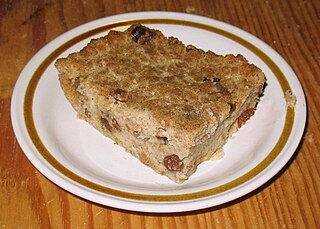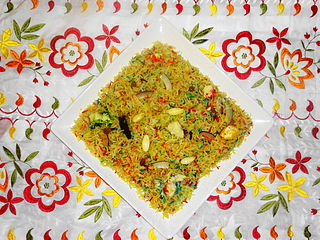
Bread pudding is a bread-based dessert popular in many countries' cuisines. It is made with stale bread and milk or cream, generally containing eggs, a form of fat such as oil, butter or suet and, depending on whether the pudding is sweet or savory, a variety of other ingredients. Sweet bread puddings may use sugar, syrup, honey, dried fruit, nuts, as well as spices such as cinnamon, nutmeg, mace, or vanilla. The bread is soaked in the liquids, mixed with the other ingredients, and baked.

Porridge is a food made by heating or boiling ground, crushed or chopped starchy plants, typically grain, in milk or water. It is often cooked or served with added flavourings such as sugar, honey, fruit, or syrup to make a sweet cereal, or it can be mixed with spices, meat, or vegetables to make a savoury dish. It is usually served hot in a bowl, depending on its consistency. Oat porridge, or oatmeal, is one of the most common types of porridge. Gruel is a thinner version of porridge and congee is a savoury variation of porridge of Asian origin.

Rice pudding is a dish made from rice mixed with water or milk and commonly other ingredients such as sweeteners, spices, flavourings and sometimes eggs.

Double ka meetha (also known as Shahi Tukra, is an Indian bread pudding sweet made of fried bread slices soaked in hot milk with spices, including saffron and cardamom. Double ka meetha is a dessert of Hyderabad. It is popular in Hyderabadi cuisine, served at weddings and parties. Double ka meetha refers to the milk bread, called "double roti" in the local Indian dialects because it swells up to almost double its original size after baking.

Iranian cuisine is the culinary traditions of Iran. Due to the historically common usage of the term "Persia" to refer to Iran in the Western world, it is alternatively known as Persian cuisine, despite Persians being only one of a multitude of Iranian ethnic groups who have contributed to Iran's culinary traditions.

A fool is an English dessert. Traditionally, fruit fool is made by folding puréed stewed fruit into sweet custard. Modern fool recipes often use whipped cream instead of custard. Additionally, a flavouring such as rose water may be added.
Shir Berenj is a rice pudding flavored with rose water, spices such as cinnamon or cardamom, and often containing almonds. It may be served warm or chilled as a dessert.

Afghan cuisine is influenced by Persian, Central Asian, and South Asian cuisines due to Afghanistan's close proximity and cultural ties. The cuisine is halal and mainly based on mutton, beef, poultry and fish with rice and Afghan bread. Accompanying these are common vegetables and dairy products, such as milk, yogurt, whey, and fresh and dried fruits such as apples, apricots, grapes, bananas, oranges, plums, pomegranates, sweet melons, and raisins. The diet of most Afghans revolves around rice-based dishes, while various forms of naan are consumed with most meals. Tea is generally consumed daily in large quantities, and is a major part of hospitality. The culinary specialties reflect the nation's ethnic and geographic diversity. The national dish of Afghanistan is Kabuli palaw, a rice dish cooked with raisins, carrots, nuts, and lamb or beef.

Bread and butter pudding is a traditional bread pudding in British cuisine. Slices of buttered bread scattered with raisins are layered in an oven dish, covered with an egg custard mixture seasoned with nutmeg, vanilla, cinnamon or other spices, then baked.

Kalamai is a traditional Chamorro corn and coconut pudding, sometimes referred to as coconut gelatin. Original versions of kalamai called for masa harina, coconut milk, sugar, and water. Subsequently, cornstarch has been used to thicken the dessert. Red or green food coloring may be used to color the kalamai, followed by a sprinkling of cinnamon on the surface. A few recipes add vanilla for additional flavoring.

Zerde is a traditional Iraqi, Mesopotamian dessert. The original rice pudding, infused with a generous amount of saffron giving it a vibrant yellow hue and a delicate floral flavour. This is a festive dish popular at weddings, births, and during holy festivities such as the first Sunday of the month of Sha'aban celebrating the birth of the prophet Zakariyya, and the first ten days of the sacred month of Muharram.

Zarda is a traditional boiled sweet rice dish, native to the Indian subcontinent, made with saffron, milk and sugar, and flavoured with cardamom, raisins, pistachios or almonds. The name 'zarda' comes from Persian word 'zard' زرد meaning 'yellow', because the food coloring added to the rice gives it a yellow color. Zarda is typically served after a meal. In the Indian subcontinent, zarda was and still remains a popular dessert on special occasions such as weddings. It is quite similar to sholezard, a traditional Iranian dessert, and zerde, a traditional Turkish dessert.

Muhallebi is a milk pudding commonly made with rice, sugar, milk and either rice flour, starch or semolina, popular as a dessert in the Middle East. While the dessert is called muhallebi in Turkey and Iraq, in the Levant and Egypt, it is called mahalabiyeh or mahalabia.

Qatari cuisine is made up of traditional Arab cuisine. Machbūs, a meal consisting of rice, meat, and vegetables, is the national dish in Qatar, typically made with either lamb or chicken and slow-cooked to give it a depth of flavour. Seafood and dates are staple food items in the country. Many of these dishes are also used in other countries in the region because they share many commonalities. In other parts of the region, some of the dishes have different names or use slightly different ingredients. One proponent of the importance of Qatar's culinary heritage is chef Noor Al Mazroei, who adapts traditional recipes to include vegan and gluten-free alternatives.

Sharbat is a drink prepared from fruit or flower petals. It is a sweet cordial, and usually served chilled. It can be served in concentrated form and eaten with a spoon or diluted with water to create the drink.














